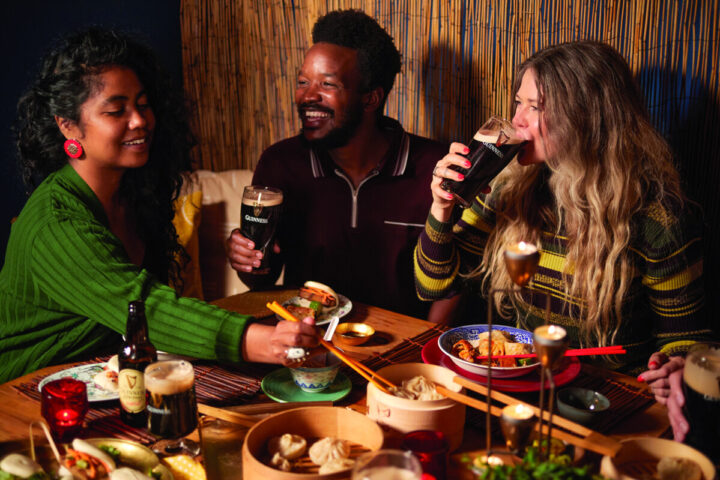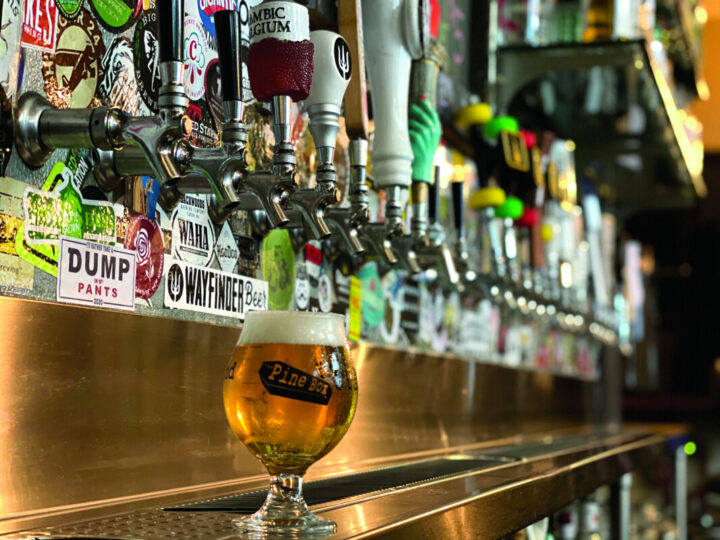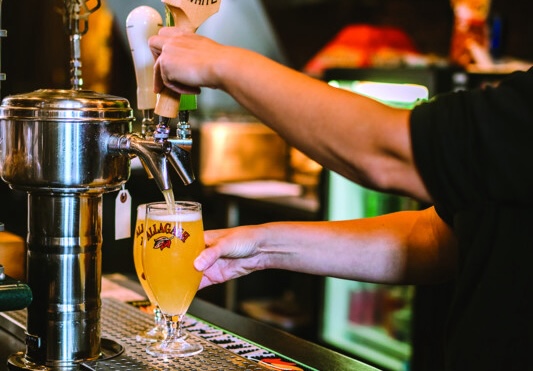
For almost a decade, on-premise research organization CGA by NIQ has measured beverage alcohol trends in the U.S., and each year, spirits consistently grabbed share from beer. But beer’s share in the on-premise is finally starting to show marginal gains following the big uptick in spirits share in pre- and post-pandemic years, with beer’s dollar sales in bars and restaurants surprisingly picking up a 0.6% gain in share to 40.5% in 2024. Beer marketers and bar operators are now cautiously optimistic that the category could benefit from the economic, demographic, and behavioral conditions that are beginning to impact the on-premise business. “Spirits had been on such a tear for a long time, but with the current economic conditions, it can be easier for beer to win in the on-premise space,” says Matthew Crompton, vice president for on-premise in the Americas at CGA by NIQ.
Still, beer’s dollar share of on-premise beverage alcohol sales remains significantly below that of spirits at 46.8%, and its velocity—along with that of spirits and wine—is down, Crompton notes. But when it comes to overall measured volume in the on-premise, beer remains the faraway leader, with an 85.4% share, compared to spirits at 8.4%, and wine at 6.3%.

Pricing Advantage
The reasons for beer’s recent dollar share gain vary, Crompton and others say. Inflation and rising prices for all offerings at the bar, not surprisingly, tend to favor beer, which is generally a lower-priced option to wine and cocktails. “We’re selling more beer now than in the past year,” says Elly Evans, bar manager at Tampa Joe’s restaurant and sports bar in Tampa, Florida. “We sell a ton of Michelob Ultra ($5 a 16-ounce pour), but customers are also asking for craft beer.” Evans says that while prices have risen on both beer and cocktails, beer may be faring better in the current environment given its relatively lower price.
Crompton notes that distribution gains by beer in the on-premise are also contributing to its share rebound. He points to a year-over-year increase in the number of sports bars and neighborhood bars—accounts that are “suited to a beer occasion”—while there’s been a decline in nightclubs, fine-dining restaurants, and premium bars, venues “which may be more suited for the spirits and wine occasion.”
Health and wellness concerns may also be slightly tipping the scale in beer’s favor. Crompton points to the increasing awareness in abv and calorie content among consumers when making drinks choices, and says, “Beer, by its very nature, wins quite well there.”
Alcohol- and calorie-content statements on beer packaging and menus have become quite commonplace, he explains, while for spirits and wine, which are typically poured from a bottle and then served to the consumer, “it’s a bit more up in the air.”
Greg Engert, beverage director and partner at Washington, D.C.-based Neighborhood Restaurant Group (NRG), says that following years of heightened interest in spirits and innovative cocktails, that trend “has minimized a bit, and people are getting back into beer.” That bodes well for NRG, which boasts more than a dozen restaurants, a number of which are heavily focused on beer. “Some of our guests may have ventured outside of beer as we built our cocktail program before, during, and after the pandemic,” he concedes, “but they’re now coming back.”
Newly legal-aged consumers, at first enthralled with spirits, may also be shifting to beer, Engert surmises, due to its relatively lower price. “The spirits interest has returned to earth a little bit, while at the same time, beer is starting to come back.” Across NRG’s portfolio of venues, beer comprises about 50% of beverage alcohol sales.

Challenges Persist
While beer’s recent gain over spirits is good news for beer marketers, many in the industry note that the category continues to face challenges in the on-premise. In addition to the economic woes, Josh Fruchtman, sales director at Maine’s Allagash Brewing Co., points to the fact that people are dining out less since Covid-19, while drinks options in general have broadened. Ellie Preslar, chief commercial officer at Sierra Nevada Brewing Co., adds that growing popularity for spirits-based RTDs could infringe on beer’s appeal to younger drinkers. “The beer industry faces an important challenge with capturing the attention and interest of newer consumer groups,” she says. Aamir Raj, senior brand manager of Guinness at Diageo Beer Co., agrees. “Consumer tastes are evolving,” he says. “They’re seeking variety and exploring new options, from spirits and RTDs to non-alcoholic serves.”
The new wave of non-alcoholic drinks—indeed, including non-alcoholic brews—is playing an increasingly large role in the on-premise, Preslar adds. “This poses a challenge against the traditional beer segment, but viewed another way, could be repositioned as an opportunity for the brewing industry to develop well-crafted, flavorful non-alcohol brews to meet the growing demand,” she says.
Draft beer, meanwhile, is still the lifeblood for beer in the on-premise. “When people go to on-premise accounts, they want something they can’t replicate at home,” remarks Crompton. Draft fills that desire as “there can be a theater of service around it, if done well, including the glassware, the pour, and clean draft lines,” he says. In recent years, though, many bar and restaurant operators have cut back on their draft beer offerings, in part due to the chaos that Covid wrought during shutdowns, the declining demand for craft beer, and consumer exhaustion with an overwhelming number of beer options on tap.
“Draft beer remains a significant part of the overall beer industry,” says Preslar. “It’s not going away, especially when you consider that the consumer experience of drinking a cold draft beer only happens in the on-premise.” Still, the Sierra Nevada executive notes, “the days of so-called ‘rotation nation’ seem to be wanning, though there are still a good number of specialty bars that successfully use this model.” The benefit of a scaled-down draft list is that operators can better predict sales, Preslar adds, and consumers are ensured of a fresh product.
Mark Young, founder and CEO of BeerBoard, which provides real-time data and insights for the on-premise beverage alcohol industry, says the scaling back of draft handles makes sense for a number of operators. Bars and restaurants today need to consider price point, flavor profile, and offering the freshest product, he explains. “Look at your assortment and find the right number of brands. If you offer too many, you tend to dilute the opportunity,” Young advises. While he says that the right number of draft offerings depends on the account, BeerBoard has found that, in general, bars and restaurants are over indexing on draft handles by some 30%. The company—which counts casual dining chains like Buffalo Wild Wings, Twin Peaks, and Winking Lizard among its clients—recommends venues focus on high-margin, high-performing brands on draft.
Seattle’s the Pine Box, which opened 13 years ago with a craft beer focus, has cut back on its draft offerings in recent years, owner Ian Roberts notes. While all of its 35 draft handles used to pour just brews, today five to seven of the handles serve up pre-mixed cocktails, wines, and ciders. “The days of 64 taps are over,” the restaurateur remarks. Indeed, beverage alcohol sales at the Pine Box are now split evenly between beer and spirits. But Engert says that NRG—which, in addition to restaurants, now runs two breweries—hasn’t cut back on its draft beer offerings. “We remain steadfast in our commitment to independent breweries,” he says. “We’re trying to expand our guests’ understanding about craft beer and build their experiences.” Draft accounts for 50% of NRG’s beer sales.
Bar and restaurant operators say they’ll continue to work to drive beer sales in their accounts, relying on tried-and-true practices, as well as a little innovation. The Pine Bar, for example, continues to tie in events to the annual Seattle Beer Week, Roberts says, while it recently played host to a brewery-sponsored Matchbox car race. Tampa Joe’s, meanwhile, offered up freshly brewed Budweiser, compliments of the local Anheuser-Busch brewery, this spring as part of its watch party for the Tampa Bay Rays’ season opener. BeerBoard’s Young sees opportunity for its smart menus with QR codes that allow bar and restaurant patrons to view details on the venue’s beer offerings. “It’s an efficient tool for today’s digitally savvy consumer,” he says.

Critical Channel
Regardless of growth trends, the on-premise channel is critically important to the health of the beer category, and beer is vital to a healthy on-premise industry. According to CGA by NIQ, the on-premise generates 44% of beer sales by value. Marketers point to the vital role that bars and restaurants play in generating trial for products. “People are more open to experimentation at a bar or restaurant,” says Allagash’s Fruchtman. “That great experience in the on-premise is a key element to building affinity in the off-premise.” Diageo’s Raj adds that the on-premise is “where beer becomes part of real experiences, not just something you buy, but something you share. It’s where loyalty is built and rituals are formed.”
While it’s likely beer will continue to experience volume challenges in the on-premise for the foreseeable future, beer marketers, operators, and observers say there’s no reason the category can’t continue to gain share of beverage alcohol. “It comes down to offering the right products to the right people in the right places,” says Crompton. “Beer can do that well. And at a time when consumers might be financially challenged, beer can still be that affordable luxury.”